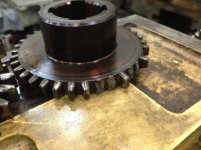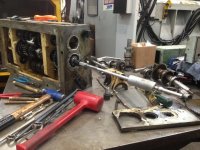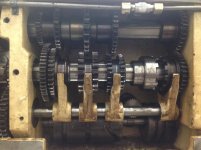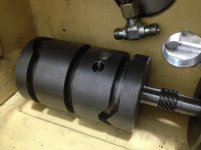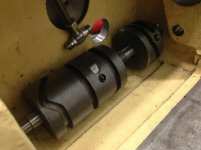ewlsey
Diamond
- Joined
- Jul 14, 2009
- Location
- Peoria, IL
I thought someone might like to see a job I recently completed. I was asked to look at a Polish made Haco TUR lathe. The exposed gears that drove the quick change gearbox had broken a few teeth and ready to be replaced. Apparently it's happened before. That seemed really odd to me.
I tried turning the input shaft on the box and it would turn but seemed to catch intermittently when shifted between two gears. I figured there was something floating around and jamming the gears or the forks were bent and allowing two gears to engage at the same time.
I pulled the gear box and it was immediately obvious what happened. The center section of the gearbox has two barrel cams that shift the sliding gears. The barrel cams are keyed to a shaft. Rotating the cam slides the forks and in turn slides the gears. These are straight spur gears so there is no side load on the shift forks.
The cams are keyed, but the only thing that locates them axially on the shaft is a dog point set screw that engages a spotted hole drilled in the shaft. After many many hours of use the set screw had backed out allowing the cam to slide freely. As a result, the gears could slide over and engage two ratios at the same time. When that happens, something has to give...
Here is a video of the problem.
I tried turning the input shaft on the box and it would turn but seemed to catch intermittently when shifted between two gears. I figured there was something floating around and jamming the gears or the forks were bent and allowing two gears to engage at the same time.
I pulled the gear box and it was immediately obvious what happened. The center section of the gearbox has two barrel cams that shift the sliding gears. The barrel cams are keyed to a shaft. Rotating the cam slides the forks and in turn slides the gears. These are straight spur gears so there is no side load on the shift forks.
The cams are keyed, but the only thing that locates them axially on the shaft is a dog point set screw that engages a spotted hole drilled in the shaft. After many many hours of use the set screw had backed out allowing the cam to slide freely. As a result, the gears could slide over and engage two ratios at the same time. When that happens, something has to give...
Here is a video of the problem.




